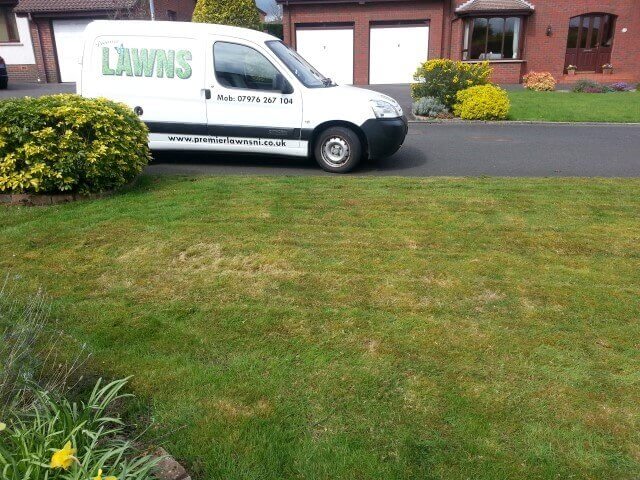 | 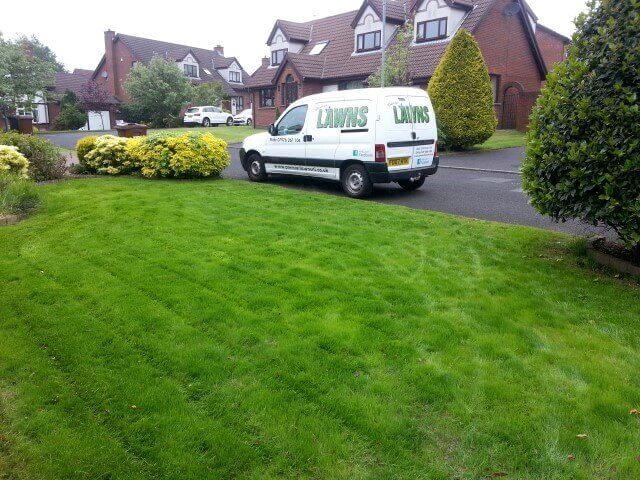 |
A typical Premier lawn before and after spring lawn treatment.
On the left you can see the uneven colouring that is a classic sign on moss infestation. There are areas of dead grass and where the grass is alive it’s not the vibrant green colour of really happy grass.
The picture on the right was taken 1 month after scarification, aeration and feeding. The grass looks much healthier, the sward is thicker and although there’s a little way to go, it’s well on it’s way to being the ideal summer lawn for a beautiful Irish garden.
So to get your lawn fresh for spring, there’s a little bit of refurbishment to be done. Just like spring cleaning your cupboards. You’ll need to make a mess to clear one up.Spring lawn treatment check list
- Tackle moss
- Tackle drainage and soil compaction (main causes of moss infestation)
- Improve the soil
- Overseed thinning or bare areas
- Nourish the grass plants
First: Tackle the moss
Moss does have its charms but in a lawn, you’ll ignore it at your peril. In the space of 2-3 years, a small patch of moss will spread and it can suffocate almost every blade of grass. Moss isn’t like grass, it doesn’t tolerate foot traffic and it doesn’t look nice in the long term.As winter draws into spring, moss really is easy to spot. Tackle it with a first degree spring lawn treatment.How to get rid of moss
It’s important to remove the moss from the lawn AND get rid of its hiding place at the same time. Moss spores tend to get lodged in the thatch layer of a lawn. Thatch is that brown, matted stuff you sometimes find if you rummage about at the base of the grass plants.That’s where scarification comes in.How to scarify your lawn
Scarification looks brutal and I can’t deny it –it is brutal. It certainly declutters the surface of your lawn. You can do it yourself using a spring-tine rake but be prepared to spend a long time on it and have aching shoulders by the time you’ve finished.I use a mechanical scarifier. It has rotating blades that loosen and remove everything from the lawn that isn’t firmly rooted in. So that’s moss, thatch and the weaker grass plants.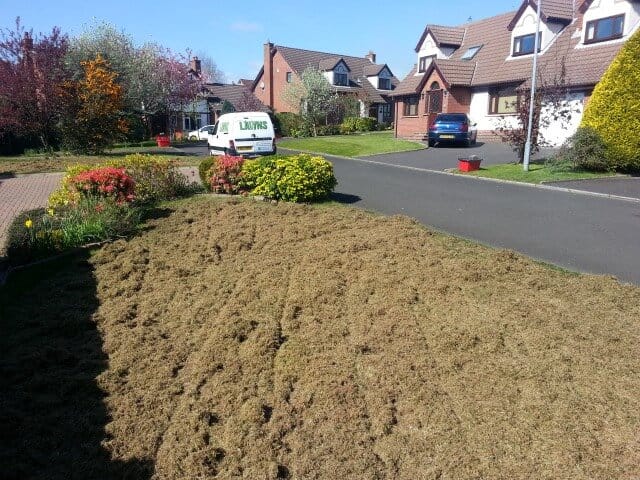
Here’s the same lawn from the before and after pics above. This is after scarification but before I’ve taken away the debris. Can you believe the amount of moss and detritus that was lurking on the surface of the lawn? No wonder the grass plants looked a bit pale!
You can hire a mechanical scarifyer from most tool hire shops. The trick is to take out as much rubbish as possible without damaging healthy plants. That was an important part of my training. If you’re not confident handling a scarifyer, I’m more than happy to scarify your lawn and leave you to carry out the rest of your spring lawn treatment.Scarifying might make your lawn look a bit sorry for itself for a couple of weeks. You’ll most likely be shocked at the amount of bare soil you can see – especially if it’s been more than 12 months since the lawn was last scarified. But growing in that soil will be a very healthy root stock of strong grass plants. These will form the basis of your new, improved lawn.Next: Let the roots breathe
After scarifying it’s important to do everything possible to encourage the remaining grass plants to grow strongly and fill in the bare areas. All parts of the grass plant need to be able to breathe. Even the ones under the ground.The winter we’ve just had has left our Belfast clay soils in pretty poor condition. Clay soils have some really positive points. However, they also have their downfall. One of those is drainage. Clay easily becomes waterlogged. That means that the little air spaces between the soil particles are filled with water. Air is driven out of the soil and plant roots suffer. (Not just grass plants, where there are tree roots beneath the lawn, these suffer too). A healthy soil should be roughly 50% solids, 25% water and 25% air.An essential lawn spring lawn care job on any soil type, but particularly for clay soils, is hollow tine aeration.Understanding lawn aeration
Hollow tine aeration creates tiny channels from the surface of the lawn down into the soil so that water can percolate through easily and air can reach the roots. It encourages deeper rooting and helps nurture stronger plants.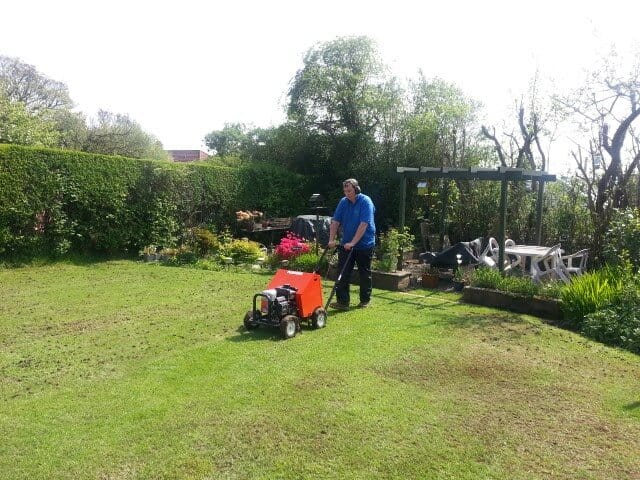
Hollow tine aerating a lawn in late spring. You can see the little cores on the left hand side of the lawn.
There are 3 types of aeration:
Solid tine aeration is the equivalent of poking holes with a garden fork. A garden fork is a time-consuming way to spike a whole lawn so I use a custom made machine. Solid tine aeration is helpful in summer and in winter. It gets oxygen to the plant roots, lets excess carbon dioxide escape from the soil and helps water percolate away from the surface of the lawn. Keeping the top of the lawn “dry” helps control fungal diseases and moss.Slit aeration: This is helpful when you want to encourage fescues or bent grasses to generate new plants – it cuts through stolons and rhizomes and stimulates new plants to grow from the wounds. It can also be used to discourage annual meadow grass – AMG hates having its roots cut. However, slit aeration only works on the very surface of the lawn, it doesn’t help with drainage or compaction.Hollow tine aeration: The only type of aeration that tackles the causes of moss. Compaction and poor drainage. I use a machine that lifts cores of soil out onto the surface of the lawn. It looks messy to start with but it won’t take long to tidy up and the long term effects are so much better than any amount of messing about with chemicals to kill moss. Hollow tine aeration creates growing conditions that favour grasses and discourage moss. Why fight nature when you can work with her?Now improve the soil beneath your lawn
As we’ve already mentioned, clay soils have their limitations. That’s because clay is made of very fine particles. Because the particles are tiny, they sit close together with no room between them for air or water. Walk on clay soil and it compacts easily, squeezing out most of the air and water and creating an inhospitable place for plants.Immediately after hollow tine aerating is the ideal time to work on improving soil structure. Now, if you have a lawn growing on top of the soil, you can’t be digging in manure the way you can on your allotment. But you can topdress.Topdressing involves filling the holes left by aeration with a growing medium with the opposite physical properties to clay. So clay has very little organic matter in it and it has teeny tiny soil particles. So, when I’m topdressing I’ll brush sand (large particles) and organic soil into the holes. Over time, it makes a huge difference to the condition of a lawn.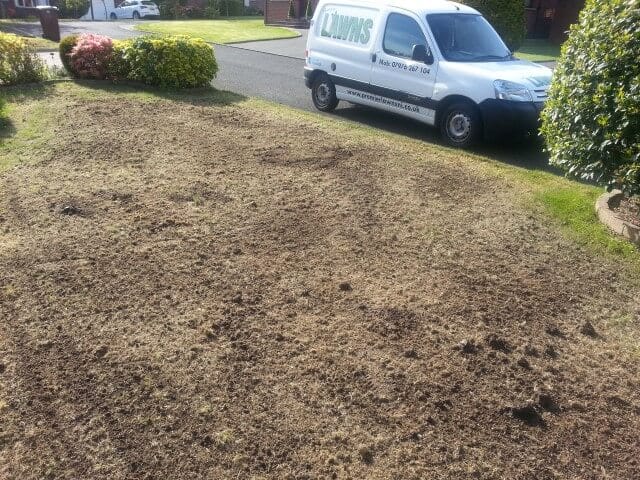
Here’s our “before and after” lawn following scarifying, topdressing and overseeding. You can see the healthy lawn grasses poking through the topdressing – it really is a very thin layer, designed to supplement and improve the soil, not to replace it.
If the lawn looks very bare after scarification, I’ll sometimes speed up the recovery process by overseeding after topdressing.Feed the plants – a vital spring lawn treatment
When a person or a pet is recovering from surgery, its important that they have extra good nutrition. The same applies to your lawn. (and to other plants in the garden).After scarifying, aeration and topdressing your lawn will have been through a lot. A simple feed with good quality fertiliser is essential. I would recommend applying a fast-acting seaweed tonic too – it contains plant growth hormones to encourage a quick recovery.Top up soil nutrient levels with a second spring/summer feed, 8-10 weeks after the first.
